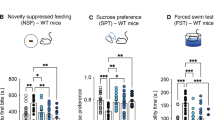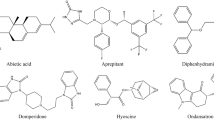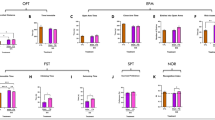Abstract
Aim:
7-O-ethylfangchinoline (YH-200) is a bisbenzylisoquinoline derivative. The aim of this study was to investigate the antidepressant-like action and underlying mechanisms of YH-200 in mice.
Methods:
Mice were treated with YH-200 (15, 30, and 60 mg/kg, ig) or tetrandrine (30 and 60 mg/kg, ig) before conducting forced swimming test (FST), tail suspension test (TST), or open field test (OFT).
Results:
YH-200 (60 mg/kg) significantly decreased the immobility time in both FST and TST, and prolonged the latency to immobility in FST. YH-200 (60 mg/kg) was more potent than the natural bisbenzylisoquinoline alkaloid tetrandrine (60 mg/kg) in FST. Pretreatment with α1-adrenoceptor antagonist prazosin (1 mg/kg), β-adrenoceptor antagonist propranolol (2 mg/kg), dopamine D1/D5 receptor antagonist SCH23390 (0.05 mg/kg), dopamine D2/D3 receptor antagonist haloperidol (0.2 mg/kg) or AMPA receptor antagonist NBQX (10 mg/kg) prevented the antidepressant-like action of YH-200 (60 mg/kg) in FST. In contrast, pretreatment with α2 adrenoceptor antagonist yohimbine (1 mg/kg) augmented the antidepressant-like action of YH-200 (30 mg/kg) in FST. Chronic administration of YH-200 (30 and 60 mg/kg for 14 d) did not produce drug tolerance; instead its antidepressant-like action was strengthened. Chronic administration of YH-200 did not affect the body weight of mice compared to control mice.
Conclusion:
YH-200 exerts its antidepressant-like action in mice via acting at multi-targets, including α1, α2 and β-adrenoceptors, D1/D5 and D2 /D3 receptors, as well as AMPA receptors.
Similar content being viewed by others
Log in or create a free account to read this content
Gain free access to this article, as well as selected content from this journal and more on nature.com
or
References
Feder A, Nestler EJ, Charney DS . Psychobiology and molecular genetics of resilience. Nat Rev Neurosci 2009; 10: 446–57.
Nestler EJ, Barrot M, DiLeone RJ, Eisch AJ, Gold SJ, Monteggia LM . Neurobiology of depression. Neuron 2002; 34: 13–25.
Páez-Pereda M . New drug targets in the signaling pathways activated by antidepressants. Prog Neuropsychopharmacol Biol Psychiatry 2005; 29: 1010–6.
Millan MJ . On 'polypharmacy' and multi-target agents, complementary strategies for improving the treatment of depression: a comparative appraisal. Int J Neuropsychopharmacol 2013; 17: 1009–37.
O'Leary OF, Dinan TG, Cryan JF . Faster, better, stronger: towards new antidepressant therapeutic strategies. Eur J Pharmacol 2015; 753: 32–50.
Demyttenaere K . Agomelatine: a narrative review. Eur Neuropsychopharmacol 2011; 21 Suppl 4: S703–9.
Protais P, Arbaoui J, Bakkali EH, Bermejo A, Cortes D . Effects of various isoquinoline alkaloids on in vitro3H-dopamine uptake by rat striatal synaptosomes. J Nat Prod 1995; 58: 1475–84.
Semwal DK, Semwal RB, Vermaak I, Viljoen A . From arrow poison to herbal medicine — the ethnobotanical, phytochemical and pharmacological significance of Cissampelos (Menispermaceae). J Ethnopharmacol 2014; 155: 1011–28.
Porsolt RD, Bertin A, Jalfre M . Behavioral despair in mice: a primary screening test for antidepressants. Arch Int Pharmacodyn Ther 1977; 229: 327–36.
Gundersen BB, Blendy JA . Effects of the histone deacetylase inhibitor sodium butyrate in models of depression and anxiety. Neuropharmacology 2009; 57: 67–74.
Steru L, Chermat R, Thierry B, Simon P . The tail suspension test: a new method for screening antidepressants in mice. Psychopharmacology (Berl) 1985; 85: 367–70.
Zhang Q, Yu YP, Ye YL, Zhang JT, Zhang WP, Wei EQ . Spatiotemporal properties of locomotor activity after administration of central nervous stimulants and sedatives in mice. Pharmacol Biochem Behav 2011; 97: 577–85.
Wang ZJ, Zhang XQ, Cui XY, Cui SY, Yu B, Sheng ZF, et al. Glucocorticoid receptors in the locus coeruleus mediate sleep disorders caused by repeated corticosterone treatment. Sci Rep 2015; 5: 9442.
Castagné V, Moser P, Roux S, Porsolt RD . Rodent models of depression: forced swim and tail suspension behavioral despair tests in rats and mice. Curr Protoc Neurosci 2011; Chapter 8: Unit 8.10A.
Borsini F . Role of the serotonergic system in the forced swimming test. Neurosci Biobehav Rev 1995; 19: 377–95.
Chen Y, Chen M, Sun C, Li D . Study on acute toxicity of tetrandrine in male SD rats by intragastric administration. J Pract Med 2011; 27: 24–5. Chinese.
Elhwuegi AS . Central monoamines and their role in major depression. Prog Neuropsychopharmacol Biol Psychiatry 2004; 28: 435–51.
Millan MJ . The role of monoamines in the actions of established and “novel” antidepressant agents: a critical review. Eur J Pharmacol 2004; 500: 371–84.
Brunello N, Mendlewicz J, Kasper S, Leonard B, Montgomery S, Nelson J, et al. The role of noradrenaline and selective noradrenaline reuptake inhibition in depression. Eur Neuropsychopharmacol 2002; 12: 461–75.
Leonard BE . The role of noradrenaline in depression: a review. J Psychopharmacol 1997; 11 Suppl 4: S39–47.
Brunello N, Blier P, Judd LL, Mendlewicz J, Nelson CJ, Souery D, et al. Noradrenaline in mood and anxiety disorders: basic and clinical studies. Int Clin Psychopharmacol 2003; 18: 191–202.
Nutt DJ . The role of dopamine and norepinephrine in depression and antidepressant treatment. J Clin Psychiatry 2006; 67 Suppl 6: 3–8.
Danysz W, Kostowski W, Kozak W, Hauptmann M . On the role of noradrenergic neurotransmission in the action of desipramine and amitriptyline in animal models of depression. Pol J Pharmacol Pharm 1986; 38: 285–98.
Kaster MP, Raupp I, Binfaré RW, Andreatini R, Rodrigues ALS . Antidepressant-like effect of lamotrigine in the mouse forced swimming test: evidence for the involvement of the noradrenergic system. Eur J Pharmacol 2007; 565: 119–24.
Stone EA, Lin Y, Quartermain D . Immobility from administration of the alpha1-adrenergic antagonist, terazosin, in the IVth ventricle in rats. Neurosci Lett 2003; 353: 231–3.
Flugge G, van Kampen M, Meyer H, Fuchs E . Alpha2A and alpha2C-adrenoceptor regulation in the brain: alpha2A changes persist after chronic stress. Eur J Neurosci 2003; 17: 917–28.
Millan MJ, Newman-Tancredi A, Audinot V, Cussac D, Lejeune F, Nicolas JP, et al. Agonist and antagonist actions of yohimbine as compared to fluparoxan at alpha(2)-adrenergic receptors (AR)s, serotonin (5-HT)(1A), 5-HT(1B), 5-HT(1D) and dopamine D(2) and D(3) receptors. Significance for the modulation of frontocortical monoaminergic transmission and depressive states. Synapse 2000; 35: 79–95.
Goldberg MR, Robertson D . Yohimbine: a pharmacological probe for study of the alpha2-adrenoceptor. Pharmacol Rev 1983; 35: 143–80.
O'Donnell JM, Frith S, Wilkins J . Involvement of beta-1 and beta-2 adrenergic receptors in the antidepressant-like effects of centrally administered isoproterenol. J Pharmacol Exp Ther 1994; 271: 246–54.
Dailly E, Chenu F, Renard CE, Bourin M . Dopamine, depression and antidepressants. Fundam Clin Pharmacol 2004; 18: 601–7.
Dunlop BW, Nemeroff CB . The role of dopamine in the pathophysiology of depression. Arch Gen Psychiatry 2007; 64: 327–37.
Takamura N, Nakagawa S, Masuda T, Boku S, Kato A, Song N, et al. The effect of dopamine on adult hippocampal neurogenesis. Prog Neuropsychopharmacol Biol Psychiatry 2014; 50: 116–24.
D'Aquila PS, Collu M, Gessa GL, Serra G . The role of dopamine in the mechanism of action of antidepressant drugs. Eur J Pharmacol 2000; 405: 365–73.
Takahashi H, Yoshida K, Higuchi H, Shimizu T, Inoue T, Koyama T . Addition of a dopamine agonist, cabergoline, to a serotonin-noradrenalin reuptake inhibitor, milnacipran as a therapeutic option in the treatment of refractory depression: two case reports. Clin Neuropharmacol 2003; 26: 230–2.
Li Y, Zhu ZR, Ou BC, Wang YQ, Tan ZB, Deng CM, et al. Dopamine D2/D3 but not dopamine D1 receptors are involved in the rapid antidepressant-like effects of ketamine in the forced swim test. Behav Brain Res 2015; 279: 100–5.
Salvadore G, Singh JB . Ketamine as a fast acting antidepressant: current knowledge and open questions. CNS Neurosci Ther 2013; 19: 428–36.
Zarate CA Jr, Singh JB, Carlson PJ, Brutsche NE, Ameli R, Luckenbaugh DA, et al. A randomized trial of an N-methyl-D-aspartate antagonist in treatment-resistant major depression. Arch Gen Psychiatry 2006; 63: 856–64.
Machado-Vieira R, Salvadore G, DiazGranados N, Zarate CA . Ketamine and the next generation of antidepressants with a rapid onset of action. Pharmacol Ther 2009; 123: 143–50.
Lapidus KA, Soleimani L, Murrough JW . Novel glutamatergic drugs for the treatment of mood disorders. Neuropsychiatr Dis Treat 2013; 9: 1101–12.
Alt A, Nisenbaum ES, Bleakman D, Witkin JM . A role for AMPA receptors in mood disorders. Biochem Pharmacol 2006; 71: 1273–88.
Nations KR, Dogterom P, Bursi R, Schipper J, Greenwald S, Zraket D, et al. Examination of Org 26576, an AMPA receptor positive allosteric modulator, in patients diagnosed with major depressive disorder: an exploratory, randomized, double-blind, placebo-controlled trial. J Psychopharmacol 2012; 26: 1525–39.
Koike H, Iijima M, Chaki S . Involvement of AMPA receptor in both the rapid and sustained antidepressant-like effects of ketamine in animal models of depression. Behav Brain Res 2011; 224: 107–11.
Acknowledgements
This study was funded by grants from the National Natural Science Foundation of China (No 81173031, 81202511, and 81302746).
Author information
Authors and Affiliations
Corresponding author
Rights and permissions
About this article
Cite this article
Sheng, Zf., Cui, Xy., Cui, Sy. et al. Involvement of adrenoceptors, dopamine receptors and AMPA receptors in antidepressant-like action of 7-O-ethylfangchinoline in mice. Acta Pharmacol Sin 36, 949–956 (2015). https://doi.org/10.1038/aps.2015.57
Received:
Accepted:
Published:
Issue date:
DOI: https://doi.org/10.1038/aps.2015.57



